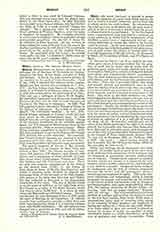

Merida (EMERITENSIS IN INDUS), Diocese of, a suffragan see of Santiago of Venezuela or Caracas, comprises the State of Los Andes, and part of Zulia and Zamora. It lies in the northwestern portion of the republic, to the south of Lake Maracaibo. Until January 17, 1905, it included the territory of the Goajira. Merida was first erected into a bishopric on February 17, 1777. Its first bishop, Juan Ramos de Lora, a Franciscan, b. at Palacios y Villafranca, Diocese of Seville, in 1722, was nominated in the consistory of September 23, 1782, and was a suffragan of Santa Fe de Bogota. His immediate successors were Emanuelo Candido de Terrissos in 1791; and in 1795 Antonio Espinosa, of Corvera in the Diocese of Saragossa. In 1801 Pius VII appointed Jaime Hernandez Milanes of Nieza, in the Diocese of Salamanca. By a Bull of the same pontiff, “In Universalis Ecclesiae”, October 24, 1803, Merida became suffragan to Caracas, which had just been raised to the archiepiscopal rank. In 1816 Rafael Laso de La Vega was elected bishop. Owing to the troubles consequent on the rebellion against Spain, Leo XII nominated Bonaventura Arias in the consistory of October 2, 1826, as auxiliary bishop. When Bishop Laso was transferred to Quito, December 15, 1828, Msgr. Arias continued to govern the diocese till Gregory XVI declared him a vicar Apostolic. His successor, Jose Vicente Unda of Guanara, was nominated in the consistory of July 11, 1836, and on his death, January 27, 1842, Juan Ilario Boset, of Puerto de Gueya, was elected.
The present occupant of the see is Msgr. Antonio Raymondo Silva, b. at Caracas, June 26, 1850, and elected May 21, 1894. The diocese contains 15 vicariates, 108 parishes, 150 churches and chapels, 100 priests, and a population of about 450,000, all Catholics except about 20,000 pagans, Timotes and Mucuchic Indians, and 300 Protestants and Jews. There are only two religious congregations in the diocese at the present time (1910): (I) the Sisters of Saint Rosa of Lima, at Merida, San Cristobal, and Rubio, a diocesan order devoted to hospital and orphanage work; (2) the Servants of the Holy Family, with houses at La Grita, San Cristobal, and Tariba. The fine cathedral is dedicated to the Immaculate Conception of Our Lady. The city of Merida stands at an elevation of 5500 feet on the right bank of the Rio Chamo in a valley of the Sierra Nevada, which here rises to about 15,000 feet. It is about 60 miles from Lake Maracaibo and 300 from Caracas. The city was founded by Juan Rodriguez Suarez in 1558 under the name of Santiago de los Caballeros. It suffered severely from earthquakes notably in 1644, 1812, and 1894, notwithstanding which it is a thriving business town with 12,000 inhabitants. The old seminary was changed into a university in 1810, and still flourishes, besides that of Caracas.
A. A. MACERLEAN

